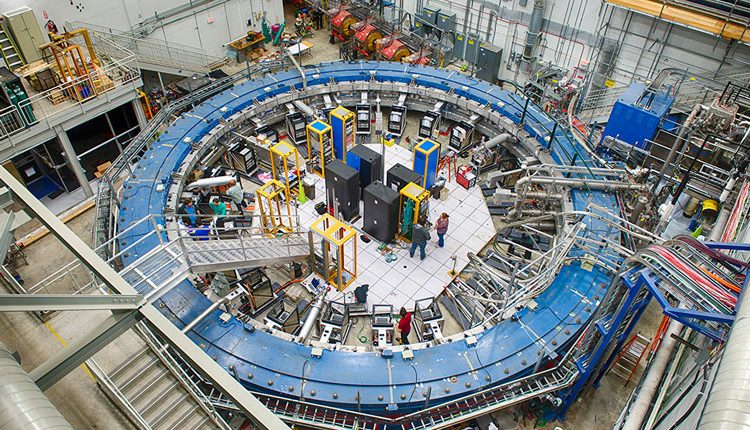What do you get when you revive a beautiful 20-year-old physics machine, carefully transport it 3,200 miles over land and sea to its new home, and then use it to probe strange happenings in a magnetic field?
A global team of more than 150 scientists and engineers, including a team from Michigan State University, is hoping for new insights into the elementary particles that make up everything.
The Muon g-2 experiment, located at the US Department of Energy’s Fermi National Accelerator Laboratory, has begun its quest for those insights. This month, the 52ft-wide superconducting electromagnet at the center of the experiment saw its first beam of muon particles from Fermilab’s accelerators. This kicks off a three-year effort to measure just what happens to those particles when placed in a stunningly precise magnetic field. The answer could rewrite scientists’ picture of the universe and how it works.
“The Muon g-2 experiment’s first beam truly signals the start of an important new research program at Fermilab, one that uses muon particles to look for rare and fascinating anomalies in nature,” said Fermilab Director Nigel Lockyer. “After years of preparation, I’m excited to see this experiment begin its search in earnest.”
Getting to this point was a long road for Muon g-2, both figuratively and literally. The first generation of this experiment took place at the U.S. DOE’s Brookhaven National Laboratory in New York State in the late 1990s and early 2000s. The goal of the experiment was to precisely measure one property of the muon – the particles’ precession, or wobble, in a magnetic field. The final results were surprising, hinting at the presence of previously unknown phantom particles or forces affecting the muon’s properties.
“These are the types of experiments typically reserved for CERN, which hosts the world’s largest particle accelerator,” said Martin Berz, MSU physics and astronomy professor who’s part of the muon experiment. “This will offer us deep insights yet will be much more cost-efficient since it’s taking place at Fermilab utilizing an existing device that can be smaller because it is made for one purpose only.”
Along with Berz, the MSU team includes: Kyoko Makino, physics and astronomy professor, and graduate students David Tarazona, Eremey Valetov and Robert Hipple. They will perform precise simulations of the beam dynamics in the experiment. The effect to be measured is extremely small, and will require the team to make a precise prediction of what is to be expected depending on the possible outcomes of the experiment.
The new experiment at Fermilab will make use of the laboratory’s intense beam of muons to definitively answer the questions the Brookhaven experiment raised. And since it would have cost ten times more to build a completely new machine at Brookhaven rather than move the magnet to Fermilab, the Muon g-2 team transported that large, fragile superconducting magnet in one piece from Long Island to the suburbs of Chicago in the summer of 2013.
The magnet took a barge south around Florida, up the Tennessee-Tombigbee waterway and the Illinois River, and was then driven on a specially designed truck over three nights to Fermilab. And thanks to a GPS-powered map online, it collected thousands of fans over its journey, making it one of the most well-known electromagnets in the world.
Over the next few weeks the Muon g-2 team will test the equipment installed around the magnet, which will be storing and measuring muons for the first time in 16 years. Later this year, they will start taking science-quality data, and if their results confirm the anomaly first seen at Brookhaven, it will mean that the elegant picture of the universe that scientists have been working on for decades is incomplete, and that new particles or forces may be out there, waiting to be discovered.
The Muon g-2 collaboration is supported by DOE’s Office of Science and the National Science Foundation.


Comments are closed, but trackbacks and pingbacks are open.